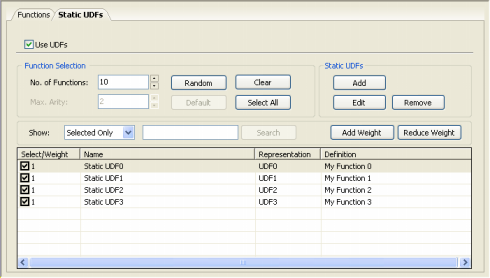| The Static UDFs Tab allows you to design your
own static
UDFs and gives access to the following
settings and features:

Use UDFs
Check this box if you want to use or design static
UDFs.
Function Selection Framework
Allows the selection of different sub-sets of UDFs very quickly
through the combination of the Show options with the
Random/Clear/Select All buttons plus the Increase/Reduce
Weight buttons.
Number of Functions
The number of functions you whish to select randomly by using
the Random button.
Maximum Arity
This box is obviously disabled as all UDFs have arity zero.
Random Button
Selects randomly a specified number of functions.
Default Button
This button is obviously disabled as it does not apply to
UDFs.
Clear Button
Clears all the functions from the function set.
Select All Button
Selects all the functions showing currently on the table.
Show List Box
Shows three different function sub-sets (All functions, Searched
functions, and Selected Only). By selecting Search, the search box
becomes activated and you can enter specific words to find functions
that match your criteria in the Name column.
Search Button
Searches, in the Name column, for the functions matching your
search words.
Add Weight
Increments by one the weight of each selected function.
Reduce Weight
Reduces by one the weight of each selected function; functions
with weight 1, though, remain as they are.
Select/Weight Column
To select a UDF, check the box on the left. By doing this, the UDF is included in your function set with the default weight of 1. To increase its weight, click the box below Select/Weight and then
introduce its weight.
Name
Column
Under this heading is shown the common name of all the UDFs.
Representation
Column
Under this heading is shown how all the UDFs
are represented in Karva notation.
Definition
Column
Under this heading is shown the definition you gave to all the UDFs.
Static UDFs Framework
Allows the introduction of static
UDFs in your function set.
Add
Button
Opens the Edit UDF window for designing a new UDF.
Edit
Button
Opens the Edit UDF window for editing an
existing UDF. To edit a
UDF, you must first select the UDF you want to modify, and then click the Edit button.
Remove Button
Removes an existing UDF. To remove a
UDF, you must first select the UDF you want to remove, and then click the Remove button. A less radical way of removing a
UDF, consists of unchecking this function or setting its weight to zero. This way you will be able to use it later if you wish.
|